A Farmdener, That’s Me
A New Word is Introduced
I’d like to introduce the words farmden and farmdener into the English language. I wonder if there are any other farmdeners out there.
What is a farmden? It’s more than a garden, less than a farm. That’s my definition, but it also could be described as a site with more plants and/or land than one person can care for sanely. A gardener and garden gone wild, out of control.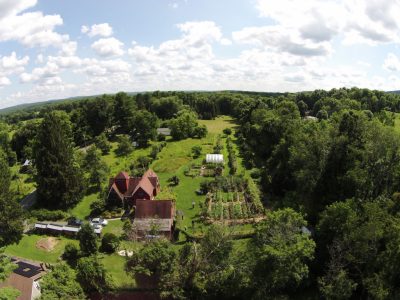
You might sense that I speak from personal experience. I am. My garden started innocently enough: A 30 by 40 foot patch of vegetables, a few apple trees, some flowers, and lawn. That was decades years ago, and in the intervening period, the lawn has grown smaller, the vegetable garden has doubled in size, and the fruit plantings have gone over the top.
Originally, I had less than acreage – 72 hundredths of an acre to be exact. But over the course of 15 years, I did manage to put my fingers onto almost every square foot of that non-acre. Squeezed into that area were 40 varieties of gooseberries, a dozen varieties of apples, a half dozen varieties of grapes, red currants, white currants, black currants, raspberries, mulberries: you get the picture. All that, in addition to my vegetables, flowers, and some shrubbery. But I was still not a farmdener, and my property was not a farmden.
Evolution of My Farmden
The transition from garden to farmden occurred with the purchase of a fertile acre-and-a-half field bordering the south boundary of my property.
With that purchase, I expanded my plantings, rationalizing that because I write about gardening (for magazines, for Associated Press, and for this blog) and host workshops here, I should test and grow a lot of what I write and talk about. So instead of 2 hardy kiwifruit vines such as any normal gardener might grow, I planted 20 vines of a few species and varieties. Instead of 2 pawpaw trees, à la normal gardener, I planted 20 pawpaw trees of few varieties.
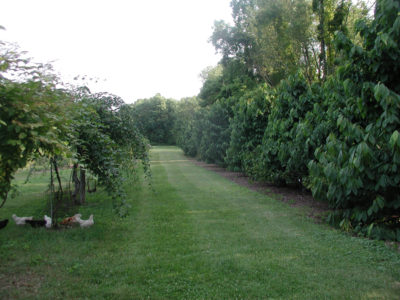
Pawpaws, blackcurrants, and hardy kiwis
And how about another dozen apple trees? And chestnuts, filberts, pine nuts (Pinus koreansis is hardy here in New York’s Hudson Valley). Again, you get the picture.
But no, I wasn’t finished. There was always one more plant needing a home, one more piece of ground hungry for a plant. Why not create another vegetable garden; after all, I had just gotten married, and that made another mouth to feed. Why buy vegetables when you have enough land to grow them?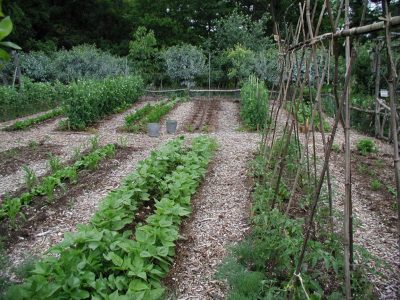 And what about winter? A greenhouse full of salad and cooking greens solved that problem, in addition to providing figs in summer and early and late season cucumbers.
And what about winter? A greenhouse full of salad and cooking greens solved that problem, in addition to providing figs in summer and early and late season cucumbers.
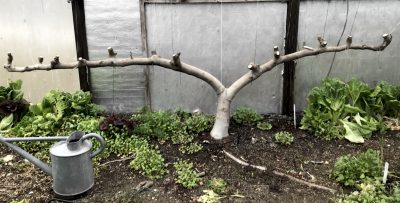
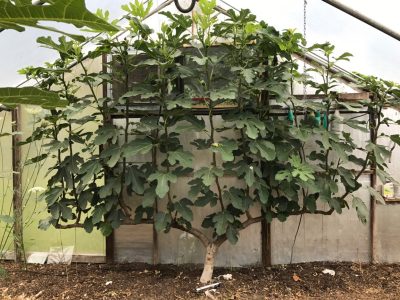
I like crown imperial (Fritillaria imperialis) flowers and learned the quirks of propagating them – pack pieces of bulb scales in moist potting soil and subject them to a few months of warm temperatures, then a few weeks of cool temperatures, pot up, plant out. Soon I had not a crown imperial or two such as you might find in most gardens, but dozens of them, and more still coming on.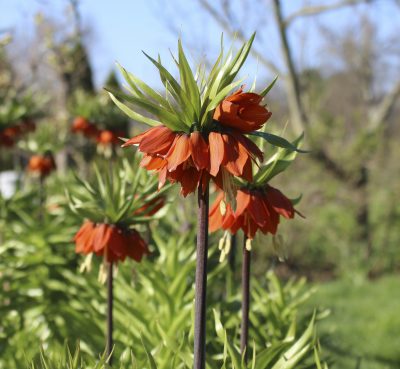
You might imagine that, despite my plantings, my lawn still grew bigger with that increased acreage. Not so. Most of the acre and a half, except what was devoted to new plantings, became a hayfield that I mowed and helped feed my compost pile. A bit of rationality prompted me to graduate from scything to a small farm tractor for brush hogging that field. (Tennis elbow, the result of excessive scything, also helped with that decision. But I still use the scythe, a high quality Austrian style scythe, to mow parts of the field.)
Present and Future
What I now had – and have – is a farmden. And I am a farmdener. A farmden is not something from which you can earn a living, although I have sold some excess pawpaws, American persimmons, and hardy kiwifruits, mostly for test marketing in my efforts to see whether these fruits are worth promoting for small farms. (They are; flavor sells.)
And my farmden is a great venue for workshops, as long as I point out that participants should pay attention to my plants, not the number of them, because my property is obviously the handiwork of a crazed gardener (or a sane farmdener?). “Don’t try this at home,” I tell participants right off the bat.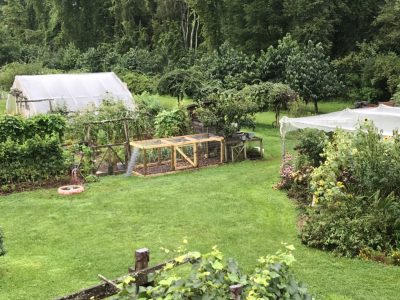
I do occasionally still garden. Right next to my terrace is a bed with tree peonies, potentiillas, clove currants, and Signet marigolds, all well-contained by the bricks of the terrace on one side and a low, moss-covered hypertufa wall on the other side. The bed is close to the house and the bed is small. Yesterday I noticed weeds starting to overstep their limit in the bed. I crouched down, started at one side of the bed, and gave it a thorough weeding, literally getting my hands on every square inch of soil. It was fun and it was quick.
Most of my time, though, is spent farmdening. It’s very satisfying, even if it does get crazy sometimes, and it yields a cornucopia of very tasty and healthful fruits and vegetables, many of them planted with an eye to beauty as well as function.
I have vowed not to plant anything more in the hayfield, in large part because it’s so pretty, the soft violet hue from midsummer’s monarda flowers grading over into a golden glow from late summer’s goldenrods. I also promised my daughter, when she was young and enthralled with Laura Ingalls Wilder, that we would leave most of the field as “prairie.” (Now over 30 years old, my daughter no longer yearns for prairies, but I’m keeping my promise.)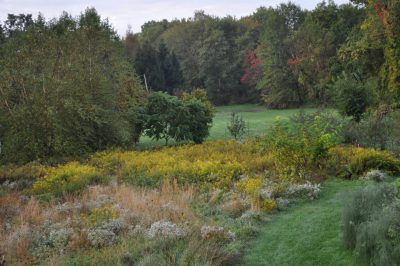
I have taken some of the edge off the transition from gardening to farmdening with some help here on the farmden from an occasional helper. Still, I am planning to keep the “den” in farmden.



Lee –
I have followed your garden articles and have purchased The Weedless Garden. I understand completely about your love for growing things. I’m working on my farmden too.
Alice
You think you have it tough? Try farmdening in a subtropical climate where winter offers even more possibilities than summer.
Perhaps, but that’s offset by your being able to grow citrus, figs (outdoors), pineapple guavas, avocados, and . . . mmmmmm. Year ’round fruits and vegetables!
It’s very impressive what you have done. I completely understand how passions grow until difficult to manage on your own. I bought a small farm in the Finger Lakes after we moved away from your area almost 20 years ago. I started planting a few heritage apples, and that became 50 by the time I was ready for something else. I then decided to plant a few English Walnuts and that became 250. I love tending to the trees and watching them grow but I know I have bitten off more than I can chew on my own. It is an obsession of sorts.
I am waiting on more trees to plant this Spring! Will I ever learn? I doubt it…
You make me feel sane. Thank you. Seriously, though, can you give each of those plants the optimum care that they need?
Love this post because we can relate to it so well! At least up until you bought the additional acreage. We’ve been in the same spot for 43 years on about 72 hundredths of an acre where most plots are half acre or smaller. When we moved in, there were foundation plantings, trees and lots of lawn. Gradually, we began converting lawn to garden beds, vegetable gardens, adding shrubs, underplanting particularly along property lines. We still have too much lawn but our efforts now are geared toward things that are less time-consuming to maintain. This year, for the first time, we are eliminating vegetable varieties that we struggle with every year and planting only things that we know will be successful, reducing the number of plants that travel in and out twice a year, etc., etc. Sometimes hard to stay true to our goal with our love of plants.
My wife and I bought our first property here in CNY a year and a half ago and your blog has been a great inspiration to me. As much as I try to ease into my 2.5 ac. forest farmden, spaces have been filling up quite fast! – especially since a portion of the property is Ash and sunlight is at a premium. Planning (unfortunately) for the demise of most of those Ash trees gives an added dimension to what and where I can plant. Spreadsheets and maps have filled up this winter with fruit trees and shrubs and I look forward to the arrival of all of the new additions. Hope to make it to one of your workshops this year! Thanks for the post!
Oh, I am tired just reading about farmdenning! My garden became too large and wild for me to tend to and so I did what any sane person would do, I sold it. I do pine for that wild growth and the goings on of the birds and critters but then again, I feel free — to paint more, to cook more, to have more frivolous fun. Of course, you cannot take the garden out of a gardener (or the farm out of a farmdener), and I am starting a new garden but I have learned. I like that you mention your tidy bed next to your terrace all bricked in that is easy to tend to … that is my foremost thought when gardening now, “will I be able to manage it?” Your farmden looks gorgeous! Someday, I hope to visit perhaps at a workshop. I always envy your fresh harvests of delicious fruit, corn, vegetables … farm on I say, farm on!!!
Hi Lee: After reading this post I just became a Farmdener working my little Farmden. I tell everyone that I have been around since before dirt and garden on about 9 acres. About 1 acre of its my farmden and the rest is up to mother nature. I like trying new things and different plants. Currently learning how to propagate plants from seed and stem cuttings. No real plan for the farmden just whatever happens is ok. I am the guy that hit you up for some of the crocosmia bulbs that are hardy to zone 5.
I will see you tomorrow at the symposium you are speaking at.
Have a great day, John
Be careful with propagation. It can become an obsession. And then you have to figure out what to do with all the plants. (I part with some of them with a spring plant sale.
Hmm…farmden?….I say major league homestead! I’m in Plattekill, in Little league. While you’re pounding home runs out of the park, I’m still trying to figure out how the catcher has the ball already. I didn’t even see it go by. But it’s fun to play the game no matter what.
Hi Lee,
I really enjoyed listiening to you and Joe Lamp’l discuss growing fruit trees. I live in zone 5, southeastern Wisconsin, about 18 miles southwest of Milwaukee. Ready to starting adding fruit trees to my landscape. Can you recommend a mail order for bare root fruit trees. I would like to start with a pear tree but, was overwelmed by the number of vaieties for my zone. Also, recommendaitons on the best Wisconsin blueberries? I will need two different varieties for pollinations, correct?
Good idea, planting fruits. For mail order nurseries, I like cumminsnursery.com and raintreenursery.com. That’s why I have them as advertisers on my blog page. As far as blueberries, I like all highbush varieties. Yes, plant at least two varieties for cross-polliination. Another advantage of planting more than one variety is that you can spread out the harvest season. Hartmannsplantcompany.com is a good mail order source for plants.
As a master gardener, a beekeeper, and 15 acres of land, I find it quite hopeless to reel in my love for growing plants. Sometimes I can throttle back during the wintertime, but springtime eventually wins out in our Northern climate. Keep writing!
Hi Lee,
Farmden – that’s a great word:) I have just found your blog and enjoyed looking through the pictures and reading. I’m also seeing for the first time pictures of unusual fruit trees eg Nanking Cherry. Books usually have only the fruit pictured.
My extension agent (in Providence, RI) mentioned your book ‘Landscaping with Fruit) when I asked her for recommendations for small fruit trees. I have requested it from my library.
I’m a home gardener who sells to farmers market and restaurants, and who is introducing customers to Asian vegetables like bitter melon:)
I plan to plant an orchard of dwarf trees- cherry, crabapple, smaller plums etc – that I can sell by the pint. Dwarf so it’s manageable.
Would you mind recommending some tasty varieties for zone 6B? I’m new to fruit trees in New England though I’ve grown citrus and pomegranate in AZ.
Thanks so much for sharing your wisdom and enthusiasm! Keep on planting!
One big difference with growing fruits here, in contrast to Arizona, is that many pests attack common fruits such as apple, peach, nectarine, plum, and apricot.Unless you want to become an expert in pest contro, and probably spray regularly, I suggest planting pears and some of the uncommon fruits covered in my book UNCOMMON FRUITS FOR EVERY GARDEN.